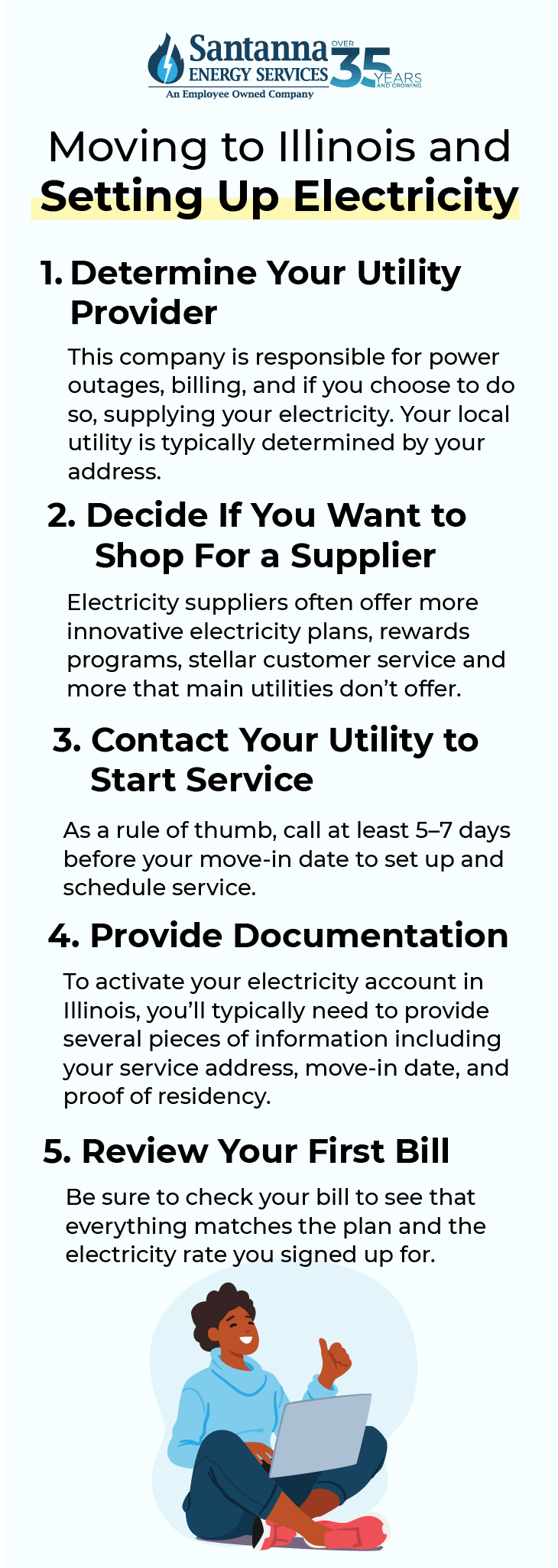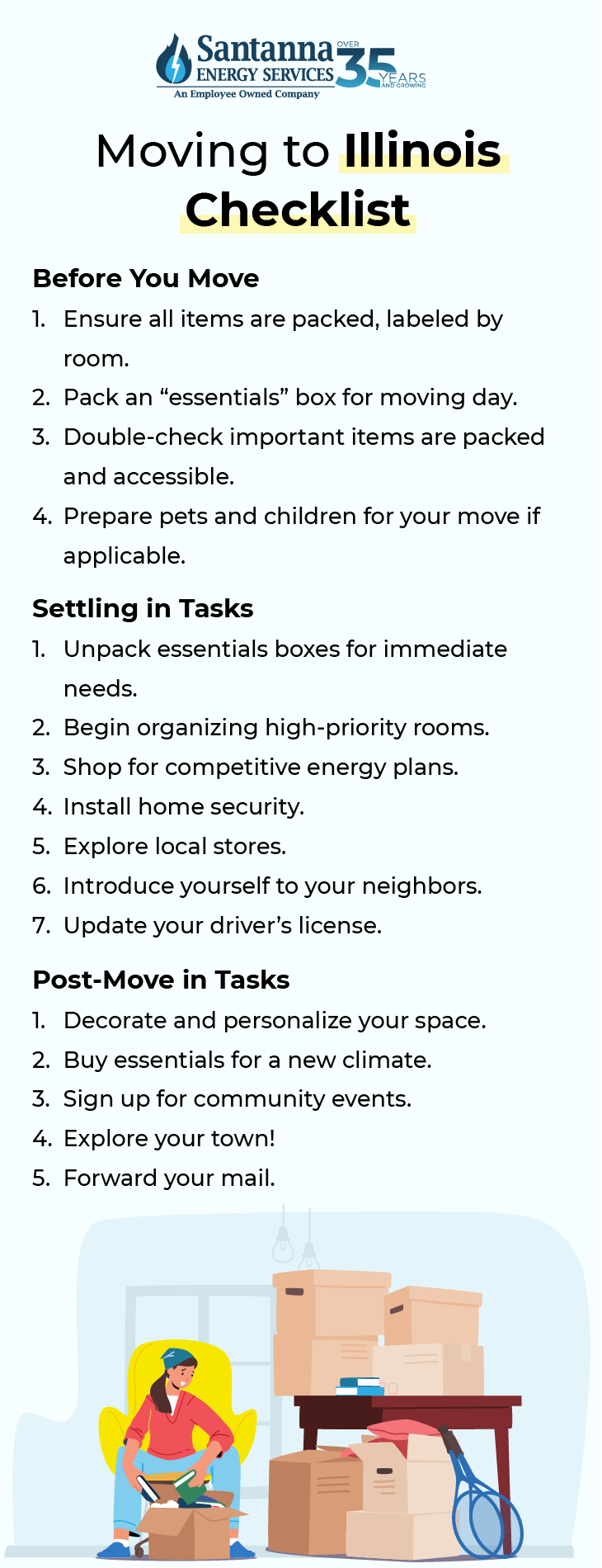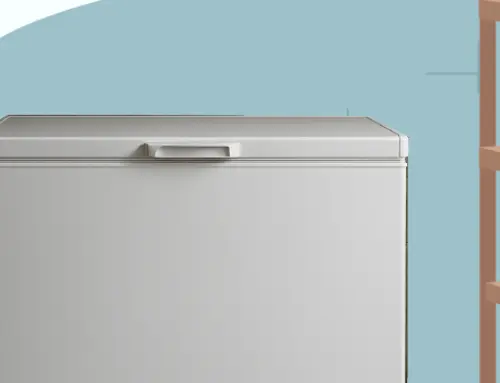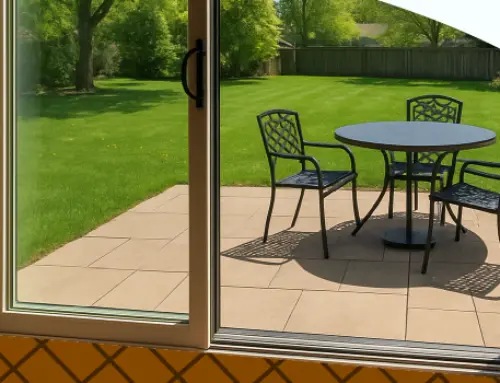Moving to Illinois and Setting Up Electricity: Your Complete Move in Guide
by Tyler Castle
21.3 min read

People are moving to Illinois, particularly to Chicago, for a mix of reasons, including job opportunities in a major economic hub, a strong job market, and a diverse cultural and recreational scene, as well as the state's affordability compared to coastal states. The state also offers a vibrant cultural landscape, from music and food to festivals and historic landmarks.
Relocating to a new state comes with a long to-do list—but one task you definitely don't want to overlook is setting up your utilities. From electricity and gas to water, internet, and waste services, ensuring everything is ready before move-in day is essential for a smooth transition.
This guide is all about helping you navigate the utility setup process in your new state of Illinois—whether you're transferring existing accounts, choosing a new supplier in a deregulated market, or starting completely from scratch. Let's hop in!
Can I Choose My Electricity Supplier in Illinois?
If you’re moving to Illinois for the first time, there’s good news! You can choose your electricity supplier in Illinois.
Illinois is a deregulated state for both electricity and natural gas. This means residential customers are not limited to choosing from just one supplier or your main utility. Instead, you can shop for certified energy suppliers that offer different plans, pricing models, and contract terms. This freedom gives you greater control over your energy costs, the type of energy you use (including renewable energy options), and the flexibility to find a plan that fits your lifestyle. Deregulation in Illinois began with the Electric Service Customer Choice and Rate Relief Law of 1997, making it one of the early adopters of energy competition in the U.S.
If your service address falls under ComEd, Ameren Illinois, or MidAmerican Energy, you have the power to choose from a list of certified electricity suppliers. These providers offer a variety of plans, including fixed-rate, flat-fee (or Unlimited), and eco-friendly energy options even if you’re moving within the state of Illinois too.
Keep in mind that if you don’t choose a supplier, you’ll automatically receive your electricity through your utility and receive a “default rate,” also known as the Price to Compare. While this rate at times might not necessarily be the most expensive, it’s worth comparing other suppliers that offer better plans that fit your lifestyle; this might pay off in the long run.
What’s the Difference Between an Illinois Utility and an Energy Supplier?
In Illinois, your electricity service involves two key players: your utility company and your energy supplier—and they serve different roles in keeping the lights on.
Your utility is responsible for the delivery of electricity to your home and billing. This includes maintaining the power lines, poles, meters, and other infrastructure. If there’s a power outage, downed line, or issue with your electric service, your utility is who you’d call. You cannot choose your utility—it’s assigned based on where you live.
An electricity supplier is the company that supplies the electricity to you to use. You can either choose to get your electricity supplied to you from a retail energy supplier or the utility itself but remember that while it might seem easier to get your electricity directly from the utility, you’ll potentially miss out on better plans and lower rates than if you choose an independent energy supplier.
Moving to Illinois and Setting Up Electricity
Once you’ve found your new place in Illinois, setting up essential utilities should be one of your top priorities. The worst thing to happen on the day you move in is to try to turn the lights on and there being no electricity because you didn’t set it up.
But don’t worry, we’ve done the work, so you don’t have to. Here’s how to take care of everything—step-by-step—so your home is livable from day one:
How to Set Up Electricity in Your New Illinois Home
Moving to Illinois and setting up electricity is a simple process with the right information. Here’s all you need to know about setting up electricity in your new Illinois home:
1. Determine your utility provider
One of the first pieces of information that will help you set up electricity in your home is knowing your utility provider. This company is responsible for power outages, billing, and if you choose to do so, supplying your electricity.
Your local utility is typically determined by your address. If you’re in Northern Illinois, your default utility is most likely ComEd (Commonwealth Edison) and if you’re living in Central or Southern Illinois, your utility is likely Ameren Illinois.
If you’re moving into your home for the first time and are unsure of your electric utility provider, start by checking The Illinois Energy Association website that offers a map that allows you to identify your electric utility provider based on your county.
As an alternative, if possible, ask the previous homeowner, tenant, or your landlord about the electric utility provider for the property. They can provide information about the existing service and any necessary steps to transfer or set up a new account. If this doesn’t pan out, your local city or village hall can be a valuable resource as they often have information about utility providers for different areas which can help you narrow down your options.
2. Decide if you want to shop for a supplier
If you’re moving to Illinois and setting up electricity for the first time in your home, determine if you want to shop for an electricity supplier or receive your energy from your main utility. Getting your electricity supply from a competitive energy supplier comes with a ton of benefits you might not know of:
- Support Earth-Friendly Energy: Many electricity suppliers offer plans that support renewable energy with eco-friendly electricity plans. If you have goals of creating an eco-friendlier planet that starts at home, going with an energy supplier and looking into these plans may be right for you.
- Get Perks: Because of the increased competition within deregulated energy markets, suppliers often offer special incentives and perks to earn your business. This can include exclusive rewards programs for customers and even referral programs where you can earn just for referring a friend.
- Choose What Fits: Perhaps the best part of choosing an independent energy supplier is that you have a variety of plans to choose from that can better match your lifestyle and budget. Instead of being stuck in a default plan, suppliers offer plans that work with your budget. For example, some electricity suppliers offer flat-fee or Unlimited Energy plans that keep your supply charge at one flat-rate making monthly budgeting more predictable.* Suppliers also offer varying contract lengths for those looking to stick around or for those who are looking for short-term energy plans to escape Illinois winters.
- Better Tools & Service: Some suppliers offer apps, usage tracking, and personalized support. Speedy and reliable customer support makes all the difference, especially when it comes to questions about your bill. Suppliers usually prioritize this skill to help you when you need it most.
- Shop & Save: While energy rates fluctuate regardless of whether you choose to get your energy from a supplier or your main utility, but prices update much more frequently on the energy supplier side than the utility side. Supplier energy rates can change daily while the Illinois utility Price to Compare changes as little as monthly or as soon as weekly in most cases. Keeping an eye on supplier prices can help you lock your energy plan at a potentially lower rate than the utility’s Price to Compare leading to potentially lower energy bills.
If you feel an electricity supplier is right for you, simply contact your chosen supplier to start service and they can help you with navigating the rest of the process!
3. Contact your utility to start service
Even if you choose a third-party electricity supplier to supply your energy, your main utility (commonly ComEd or Ameren Illinois) still handles the physical delivery of electricity to your home—and they’re who you’ll contact to start or transfer service.
As a rule of thumb, call at least 5–7 days before your move-in date. This will give your utility and supplier enough time to locate you, set up your account and switch on your electricity. Some accounts can be set up online via the utility’s customer portal or right when you notify them, you’d like to start service. Be sure to request electricity service to begin the day before or the day of your move so that you have your energy ready to use when you arrive.
4. Provide documentation
To activate your electricity account in Illinois, you’ll typically need to provide several pieces of information. This includes your new service address, your move-in date, and in some cases, a lease agreement or proof of homeownership to verify residency. Having this documentation ready ahead of time can help ensure a smooth and timely setup process.
5. Review your first bill
Once your service is live, you’ll likely receive a just one bill sent by your utility which typically includes:
- Supply Charges – the cost of the electricity you use (set by your chosen supplier or the utility’s standard rate).
- Delivery Charges – fixed and variable fees from the utility for maintaining infrastructure and delivering electricity to your home.
- Taxes and Fees – Other charges for things like maintenance or fees from the state on your electricity.
Be sure to check your bill to see that everything matches the plan and the electricity rate you signed up for. If there’s any issues with your billing, be sure to contact your utility to resolve them.

How to Select an Illinois Electricity Supplier
In Illinois, you have the power to choose your electricity supplier—but with dozens of options available, it’s important to make an informed decision that aligns with your budget, energy habits, and values. Here’s what to look for when comparing electricity suppliers:
1. Look Beyond Price
Take time to consider other factors that impact your overall satisfaction and the value of your plan—beyond just the price. Focus on your prospective energy supplier’s plan offerings. It’s also important to look into the supplier’s customer service reputation, particularly how they handle enrollment questions. Lastly, reading online reviews can also give you a sense of how responsive and reliable a supplier is when you need support..
2. Understand the Price to Compare
Before selecting a supplier, it’s important to know your utility’s “Price to Compare.” This is the rate your utility company charges if you don’t choose an alternative supplier, and it can serve as your benchmark when shopping for other plans. The current electricity rate in the Midwest as of February 2025 is $0.162 per kWh.
3. Make Sure the Provider is Certified
To protect yourself from misleading offers or unreliable service, only choose electricity suppliers certified by the Illinois Commerce Commission. Keep in mind that if you don’t select a provider, you’ll be automatically enrolled in your utility’s default rate, which may not always offer the best price or plan flexibility. Shopping around may save you money or give you access to more flexible options.
How Long Does It Take to Set Up Electricity in Illinois?
In most cases, electricity service can be started within 1–3 business days after you contact your utility company. However, this timeline can vary based on whether the service is already active at the property, whether a meter reading or technician visit is required, and the time of year (summer and early fall are high-demand moving seasons).
To avoid delays, it’s recommended that you schedule your service start date at least 5–7 business days before your move-in. This gives the utility enough time to process your request, especially if you’re a first-time customer or moving into a property where power has been off.
If your electricity is already on at your new home, your service may be activated as soon as the account is transferred to your name. If power is off at the property, a technician may need to restore service—which can add an extra day or two depending on scheduling availability.
The exact timeline of when you can get your electricity turned on in your new home can vary so it’s best to be prepared with more time than you might think to troubleshoot any issues that might come up.
How to Set Up Other Utilities in Illinois
When it comes to settling into your new home, the last thing you’ll want is to walk in your new home without the rest of your utilities ready to go. Here’s how to set up other utilities in your Illinois home:
Water Service
Water services in Illinois are usually managed by your local city or municipality. To set up water services, you can usually start by contacting your city or village water department. Many cities allow online setup to either transfer or set up a brand-new account.
In most cases, you may need to provide proof of residency, a lease or deed, and a government-issued ID to set up services and confirm your address.
Natural Gas
Natural gas is a common energy source used for heating and cooking. You’ll want this energy source set up and ready to go before your move in day. Like electricity, natural gas is deregulated in Illinois, meaning you can choose your supplier while your local utility handles delivery and maintenance.
Depending on your location, service may come from Nicor Gas, Peoples Gas, or Ameren Illinois as these are the main gas utilities in the state. The process for setting up natural gas in your home is similar to setting up electricity:
First, if you’re interested in supplying your natural gas from a certified energy supplier, you’ll want to confirm this detail first, so you know which main utility you’ll be working with. Offering the same great benefits as a competitive electricity supplier, be sure to check with your current electricity supplier and see if they offer bundled services with natural gas too! Bundling your gas and electricity services can add a level of convenience to your energy services, keeping everything under one supplier.
Once you’ve explored your options, visit your utility’s website—such as Nicor Gas, Peoples Gas, or Ameren Illinois—and look for a “Start Service” section. Typically, you’ll need your new service address, move-in date, and possibly an account number to start your new service enrollment for natural gas. Most providers allow you to submit your request online, but you can also call their customer service line for assistance. Be sure to schedule your activation at least 5–7 business days in advance of your move in date
Internet Service
Internet service options in Illinois vary by location, with a wide range of providers available depending on whether you live in an urban or rural area. Popular choices include Xfinity, AT&T Fiber, RCN, and smaller local providers that serve more remote regions.
To find and set up service, simply enter your ZIP code on provider websites to view available plans and schedule installation. As a bonus, some communities in Illinois offer public broadband initiatives or local programs to improve access—so it’s worth checking your city or county’s website for additional options or cost-saving opportunities.
Trash and Recycling
Trash and recycling services in Illinois are usually managed by your local municipality or a contracted private company, depending on where you live. To set up service, contact your city or village hall or check their official website for information on collection schedules, bin requirements, and recycling guidelines.
For example, Chicago residents receive weekly garbage pickup and biweekly recycling through the Department of Streets and Sanitation. In more rural areas, you may need to arrange service with a private hauler such as Waste Management or Republic Services.
Ensuring a Seamless Utility Transition When You Move
Moving into a new home is exciting—but forgetting to manage your utility services can lead to surprise outages, unnecessary fees, and a stressful first night. To avoid disruption and ensure everything works the moment you walk through the door, here’s how to handle your utilities like a pro;
Managing Existing Utility Accounts
Start by listing out every utility service tied to your current home like electricity, natural gas, water and sewer, trash and recycling, internet and so on to make sure you have everything you need.
If you’re moving out of a home, be sure to contact each provider at least two weeks before your move to schedule a shut-off date that matches your move-out timeline. Make sure your final meter readings are recorded, and forwarding addresses are set so you can receive any final bills or refunds.
Transfer Services to the New Home
If you’re moving within the same city or service area, you may be able to transfer utilities without interruption and stay with your current provider if you liked working with them in the past. This is often true for electricity, gas, and internet; others will vary by city and will likely require a new company. When calling to set up service at your new address be sure to provide your move-in date, confirm if a technician needs to visit, and schedule service to begin the day before or the day of your move.
Set Reminders for Account Setup Timelines
Utility transitions are time-sensitive. To ensure a smooth transition between setting up your account and ensure services reach your new home in time, it’s a good idea to set reminders. To keep yourself on track, set reminders for:
- Final bill payments on your old accounts
- Follow-up emails for confirmation
- Setup appointments and technician arrival windows
- Cancellation dates to avoid being double-billed
Consider using a moving checklist app or even setting calendar alerts so nothing slips through the cracks.
Can Utilities Be Shut Off Right Now in Illinois?
According to Illinois.gov, there are protections in place to help keep the heat and lights on during dangerously cold weather—especially for those who need it most. If you’re part of programs like LIHEAP (Low Income Home Energy Assistance Program) or PIPP (Percentage of Income Payment Plan), rely on electric heating, or you’re active military or a veteran, your utility service can’t be shut off just because you fall behind on payments during cold weather.
That said, this rule doesn’t cover disconnections due to things like tampering, theft, or safety issues.
There’s also a Cold Weather Rule that kicks in for everyone when the temperature is expected to hit 32°F or lower. During these times—and before weekends or holidays when the forecast calls for freezing temps—utilities are not allowed to disconnect residential customers, even if they’re behind on their bills.
If you’re worried about getting disconnected or already behind, the best move is to call your utility company and ask about setting up a Deferred Payment Agreement (DPA). If your power or gas has already been shut off, reach out right away—they may be able to reconnect you even if you can’t pay the full amount upfront.
Other Info to Know About Moving to Illinois
Moving to Illinois can be a big step for those especially who are moving from out of state or the first time. Before you decide on move, here’s what you should know about moving to Illinois:
What’s the Cost of Living in Illinois?
Based on the latest data from Numbeo dated March 2025, the estimated monthly expenses in Illinois—excluding rent—are approximately $4,715 for a family of four and around $1,302 for an individual. Compared to New York, overall living costs in Chicago are about 25.9% lower (excluding rent), and rental prices in Chicago average 45.6% less than those in New York.
Best Industries to Work in After Moving to Illinois
- Finance and Commerce:
Chicago, the state’s largest city, plays a major role on the global financial stage. It’s home to major institutions like the Chicago Mercantile Exchange and the Chicago Stock Exchange, and it serves as headquarters for major corporations such as Boeing and McDonald’s.
- Manufacturing:
Illinois has long been a powerhouse in manufacturing, with industries ranging from machinery and food processing to chemicals. Cities like Rockford and Peoria are well-known hubs for this sector.
- Agriculture:
Thanks to its rich, fertile soil, Illinois is among the top agricultural states in the country, particularly in corn and soybean production. Central Illinois—part of the “Corn Belt”—drives much of this output.
- Technology and Innovation:
The state is also making strides in tech. Chicago’s growing reputation as part of the “Silicon Prairie” reflects its vibrant startup scene and the presence of major tech companies.
Best Places to Live in Illinois
Whether you’re moving across the state or relocating from out of state, moving to Illinois offers a mix of vibrant suburbs and charming communities that appeal to families, professionals, and retirees alike. Here are a few standout places that consistently rank among the best to call home:
- Naperville – A perennial favorite with top-rated schools, a vibrant downtown, and a strong sense of community.
- Clarendon Hills – A peaceful, upscale suburb with quick train access to Chicago and excellent schools.
- Hinsdale – Known for its historic charm, luxury homes, and high-performing school district.
Each of these towns offers a unique lifestyle blend—whether you’re looking for a walkable downtown, family-friendly atmosphere, or quiet elegance. Check our full list of the best places to live in Illinois!
What’s the Climate Like in Illinois?
Illinois experiences all four seasons, with hot, humid summers—especially in the central and southern parts—and cold, snowy winters, particularly up north. Spring and fall are generally mild, though spring can bring more storms and rain, while fall is crisp and dry.
The state averages about 54 tornadoes per year and is prone to severe weather like thunderstorms, flooding, and ice storms. Northern Illinois tends to be cooler and snowier, central Illinois sees wider temperature swings, and southern Illinois enjoys milder winters with longer, humid summers which is helpful to know if you’re moving to Illinois.
Moving to Illinois Car Registration: Quick & Easy Checklist to Title and Register Your Vehicle
If you’re bringing your vehicle into Illinois or have recently purchased a new one, there are several steps you’ll need to follow to get it properly registered. Here’s what you need to do if you’re moving to Illinois and need to register your car:
Start by completing Form VSD 190, which is used for any updates related to titling, registration, or license plates—including new titles, plate transfers, corrections, or duplicates. If the vehicle was just purchased, you’ll also need to submit a tax form: use RUT-25 for dealer purchases or RUT-50 for private sales, along with a separate payment to the Illinois Department of Revenue.
Before submitting, double-check that all your paperwork is in order. Make sure the vehicle information on the title matches your application, that the title is properly signed over to you, and that the odometer reading, sale date, and VIN are correctly recorded.
Tax amounts vary: vehicles under $15,000 are taxed based on model year, while vehicles valued at $15,000 or more are taxed on the actual sale price. If you were issued a Temporary Registration Permit (TRP), include that number with your application. Once everything is complete, you can submit your documents by mail or in person at your nearest Secretary of State facility.
Moving to Illinois Checklist
Moving to Illinois can feel overwhelming, but a well-organized checklist makes all the difference.
Before your move, be sure to pack and label all boxes by room, prepare a dedicated “essentials” box for moving day, and double-check that critical items are accessible. If you’re moving with kids or pets, make plans to help them adjust smoothly.
Once you arrive, start by unpacking your essentials first and focus on high-priority areas in your home. It’s a great time to explore local stores, introduce yourself to neighbors, and shop around for competitive energy plans. Installing home security and updating your driver’s license are also key early steps.
In the weeks that follow, take time to decorate and make your space feel like home. Don’t forget to buy climate-appropriate essentials, forward your mail, and get involved in community events in your town!

Moving to Illinois is an exciting step, and with the right preparation, your transition can be smooth and stress-free. From choosing the right city and understanding utility setup to registering your vehicle and exploring public transportation, this guide has walked you through everything you need to know to get started.
As you settle into your new home, don’t forget one of the most important steps—choosing an energy plan that works for your lifestyle and budget. As an energy supplier of choice in the state of Illinois, we pride ourselves on providing energy plans that are unique and beneficial to your lifestyle. Explore Santanna’s better energy solutions for your home today!
* Restrictions apply. Enrollment based upon program eligibility. Customers using more than 125% of normal monthly usage as determined by Santanna may be required to switch plans.
Tyler is an experienced energy professional, having worked for Santanna Energy Services, for the past four years. He is passionate about renewable energy and believes that diversifying the energy grid is the key to a sustainable future. Tyler is dedicated to supplying consumers with the best possible energy solutions and works diligently to make sure that Santanna can deliver the highest quality service.







